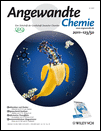Computational Evidence for Hydrogen Generation by Reductive Cleavage of Water and α-H Abstraction on a Molybdenum Complex†
K.Y. acknowledges Grants-in-Aid (Nos. 18GS0207 and 22245028) for Scientific Research from Japan Society for the Promotion of Science (JSPS) and the Ministry of Education, Culture, Sports, Science and Technology of Japan (MEXT), the Nanotechnology Support Project of MEXT, the MEXT Project of Integrated Research on Chemical Synthesis, the Kyushu University Global COE Project “Future Molecular Systems”, and CREST of the Japan Science and Technology Cooperation for their support of this work.
Graphical Abstract
Als möglicher Mechanismus der Reduktion von Wasser zu H2 wurde die reduktive Spaltung von Wasser und α-H-Abstraktion schon lange vermutet, bislang konnte aber kein eindeutiges Beispiel geliefert werden. Detaillierte DFT-Rechnungen zeigen nun, dass dieser Prozess an einem MoI-Zentrum energetisch begünstigt ist (siehe Bild). Die Bildung von H2 nach diesem Mechanismus ist auch an einem MoII-Zentrum möglich, allerdings weniger günstig.





